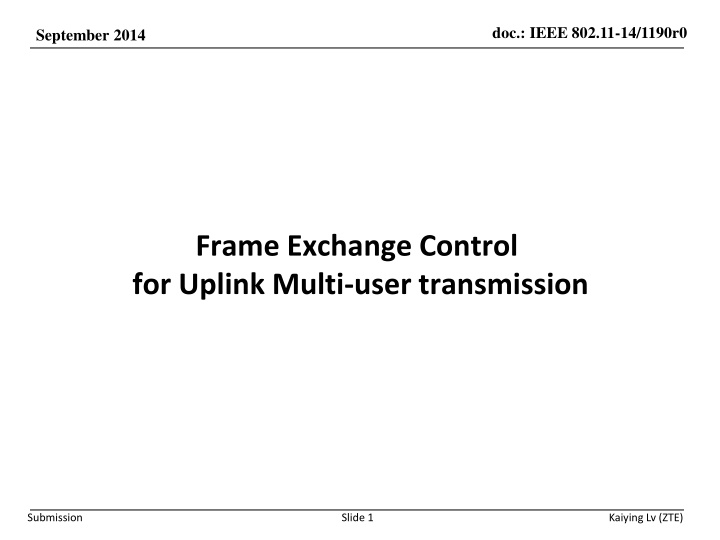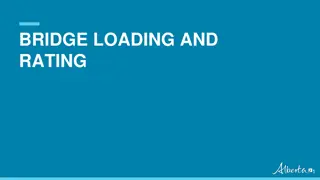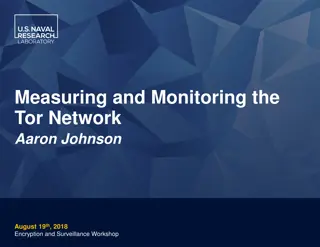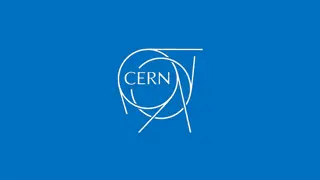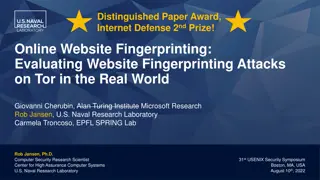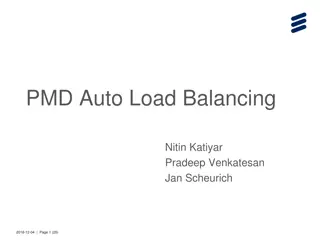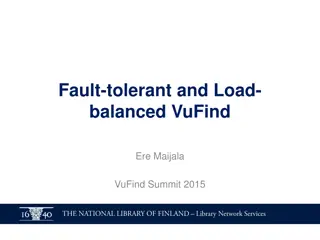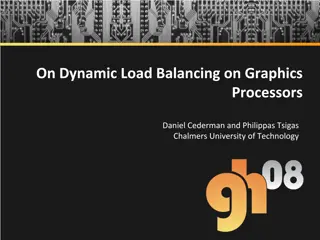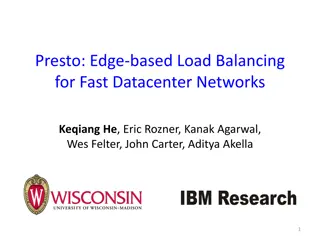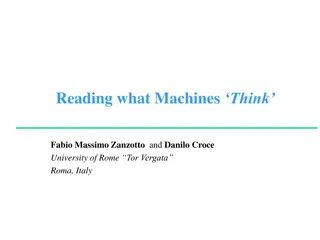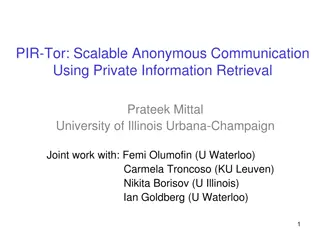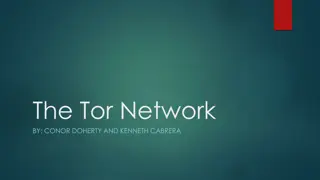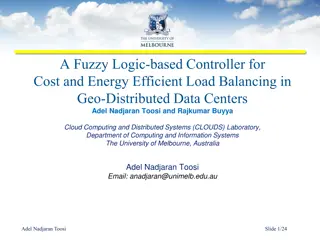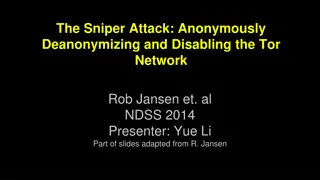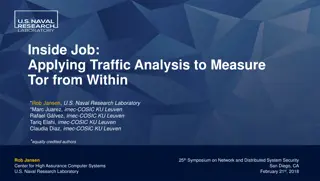Secure Load Balancing in Tor with PeerFlow
This article discusses the challenges of secure load balancing in Tor network and presents PeerFlow as a new solution to address them. It covers the existing solutions, experiment results, and the need for security against bandwidth-limited adversaries. Various problems related to exits, guards, clients, relays, and destinations are explained, highlighting the importance of balancing load securely in Tor to prevent attacks on client traffic.
Download Presentation

Please find below an Image/Link to download the presentation.
The content on the website is provided AS IS for your information and personal use only. It may not be sold, licensed, or shared on other websites without obtaining consent from the author.If you encounter any issues during the download, it is possible that the publisher has removed the file from their server.
You are allowed to download the files provided on this website for personal or commercial use, subject to the condition that they are used lawfully. All files are the property of their respective owners.
The content on the website is provided AS IS for your information and personal use only. It may not be sold, licensed, or shared on other websites without obtaining consent from the author.
E N D
Presentation Transcript
doc.: IEEE 802.11-14/1190r0 September 2014 Frame Exchange Control for Uplink Multi-user transmission Submission Slide 1 Kaiying Lv (ZTE)
doc.: IEEE 802.11-14/1190r0 September 2014 Background In the 11ax PAR, it is said that the project may include the capability to handle multiple simultaneous communications in both the spatial and frequency domains, in both the uplink (UL) and downlink (DL) direction , [1]. DL MU-MIMO has already been supported in 11ac. UL multi-user transmission was discussed in previous meetings, including UL MU-MIMO and UL OFDMA. UL MU transmission is identified as a candidate technology to improve the network efficiency in dense deployment case. The feasibility of supporting OFDMA and UL MU-MIMO has been analyzed in [2] and [3]. Submission Slide 2 Kaiying Lv (ZTE)
doc.: IEEE 802.11-14/1190r0 September 2014 Motivation A general UL MU transmission procedure has been introduced in [3]. However the detailed scheme for UL MU transmission has not been discussed yet, in particular: Multi-user polling and information indication The policy for multiple frame transmission in a UL MU TXOP Multi-user acknowledgement Error recovery In this contribution, we propose the rules for UL MU transmission in a TXOP. Submission Slide 3 Kaiying Lv (ZTE)
doc.: IEEE 802.11-14/1190r0 September 2014 Analysis The following issues should be considered to define a complete UL MU transmission protocol Multiple UL MU transmission procedure in a TXOP How to schedule multiple frame transmission in a UL MU TXOP, and control the procedure with less overhead Multi-user acknowledgement When AP receive multiple STAs UL frame, how to send the acknowledgement frame ? Sending in parallel or serial ? Error recovery When UL MU data fails, STA or AP which one initials the error recovery procedure? Is error indication needed? Flexible UL MU transmission scheduling How to schedule new STAs during a UL MU TXOP Submission Slide 4 Kaiying Lv (ZTE)
doc.: IEEE 802.11-14/1190r0 September 2014 Considerations for UL MU transmission control AP s responsibility in UL MU transmission Schedule or contend channel time for UL MU transmission Poll multiple STAs UL data and sending ack to multiple STAs. Initiate the error recovery procedure Provision assistant information for UL MU transmission Power control Time and frequency synchronization STA s responsibility in UL MU transmission Waiting AP s polling before UL MU transmission Send UL PPDU with power/time/frequency adjustment if AP indicated these information to the STA send UL PPDU with a time length which is determined by AP Easy for AP to control the transmission within the TXOP limit Easy for AP to acknowledge multiple STAs at a same time Submission Slide 5 Kaiying Lv (ZTE)
doc.: IEEE 802.11-14/1190r0 September 2014 Multi-user acknowledgement and Polling A scheme is needed to allow multiple UL MU transmissions with purposes such as: acknowledgement Polling and resource allocation error indication transmission control indication eg. time/frequency/power adjustment Principle and justice To achieve the above purposes with less overhead To keep compatibility with legacy devices A scheme using multi-user BA+Poll frame is introduced The multi-user BA + Poll frame combines the functions of BA, scheduling control error indication The multi-user BA + Poll frame can reuse the current BA frame structure The multi-user BA + Poll frame can be sent in non-HT format No additional scheduling/poll frame needed Submission Slide 6 Kaiying Lv (ZTE)
doc.: IEEE 802.11-14/1190r0 September 2014 Multi-user acknowledgement and Polling UL MU TXOP ... AP MU MU BA+poll BA+poll STA1 UL A-MPDU, More data=1 STA1 UL A-MPDU, More data=1 SIFS SIFS SIFS STA-1 STA2 UL A-MPDU, More data=1 STA2 UL A-MPDU, More data=1 STA-2 STA3 UL A-MPDU, More data=1 STA3 UL A-MPDU, More data=1 STA-3 STA4 UL A-MPDU, More data=0 Pad STA-4 Time The multi-user BA+Poll frame used during a UL MU TXOP can: acknowledgement the previous UL MU transmission schedule the next UL transmission for the current group The Duration/ID field can be reused for the next UL MU PPDU TxTime calculation Submission Slide 7 Kaiying Lv (ZTE)
doc.: IEEE 802.11-14/1190r0 September 2014 Error Recovery UL MU TXOP Containing a Null BA Information field for STA2 for Error Recovery AP MU MU BA+poll BA+poll STA1 UL A-MPDU, More data=1 STA1 UL A-MPDU, More data=1 SIFS SIFS SIFS STA-1 ... STA2 UL A-MPDU, More data=1 STA2 UL A-MPDU, More data=1 STA-2 STA3 UL A-MPDU, More data=1 STA3 UL A-MPDU, More data=1 STA-3 STA4 UL A-MPDU, More data=0 Pad STA-4 Time When one of the UL MU STAs data fails, AP can use the multi- user BA+ Poll frame for error recovery indicate receiving failure to the transmitter, a null BA information field can be used as shown in slide 12 both error indication and scheduling can be combined in same BA +Poll frame a STA can trigger retransmission in the next UL MU transmission when receiving the failure indication Submission Slide 8 Kaiying Lv (ZTE)
doc.: IEEE 802.11-14/1190r0 September 2014 Schedule new user(s) during the UL MU TXOP UL MU TXOP Containing a Null BA Information field for scheduling a new user STA5) in the TXOP AP MU MU BA+poll BA+poll STA1 UL A-MPDU, More data=1 STA1 UL A-MPDU, More data=0 SIFS SIFS SIFS STA-1 ... STA2 UL A-MPDU, More data=1 STA2 UL A-MPDU, More data=0 STA-2 STA3 UL A-MPDU, More data=1 STA3 UL A-MPDU, More data=1 STA-3 STA4 UL A-MPDU, More data=0 Pad STA-4 STA5 UL A-MPDU, More data=1 STA-5 Time AP can use the multi-user BA+ Poll frame to poll a new STA within the UL MU TXOP Poll new STA(s) for UL MU transmission Indicate the time/frequency/power adjustment information and UL resource allocation for the new STA(s) Submission Slide 9 Kaiying Lv (ZTE)
doc.: IEEE 802.11-14/1190r0 September 2014 Scheduling STAs at the beginning of a TXOP UL MU TXOP Containing Null BA Information field for Polling multi-use1and in the TXOP AP MU MU BA+poll BA+poll STA1 UL A-MPDU, More data=1 SIFS STA-1 ... ... STA2 UL A-MPDU, More data=1 STA-2 STA3 UL A-MPDU, More data=1 STA-3 STA4 UL A-MPDU, More data=0 Pad STA-4 Time AP can use the multi-user BA+Poll frame as a UL MU scheduling frame that transmitted as a initial frame of a TXOP. When transmitted as a scheduling frame, the multi-user BA+Poll frame is no longer a control response frame The new BA can use the null BA information fields to schedule multi- users of the UL MU TXOP, example of the null BA information fields is shown in slide 12 Submission Slide 10 Kaiying Lv (ZTE)
doc.: IEEE 802.11-14/1190r0 September 2014 Example of multi-user BA+Poll frame structure Per STA Info 1 16 64 4 Bits: 11 Block Ack Starting Sequence Control Polling bit AID TID Block Ack Bitmap MAC header BA information (BA+Poll) BA information (null BA information) FC Duration/ID RA TA BA contriol ... FCS Variable size BA Ack Policy Multi- TID Compressed Bitmap reserved TID_INFO Can use the reserve value for MU BA+Poll frame format indication the number of BA information field can be indicated by TID_INFO field or reserved bits Multi-user BA+Poll is almost the same as multi-TID BA We can use FC filed to indicate the new frame type or use the BA control field to indicate the new BA variant Each STA corresponds to a BA information field, the BA information fields can be a BA+Poll or a null BA The polling bit indicated whether the corresponding STA is permitted to transmit in the following UL MU PPDU AP can base on the STA s buffer status which is indicated in more data or other fields in UL data frame to determine the value of polling bit for this STA Submission Slide 11 Kaiying Lv (ZTE)
doc.: IEEE 802.11-14/1190r0 September 2014 Example of null BA information fields Per STA Info 1 16 64 4 Bits: 11 Block Ack Starting Sequence Control Polling bit AID TID All zeros Per STA Info 1 16 64 4 Bits: 11 Block Ack Starting Sequence Control Polling bit UL power Syc info indication Channel resources indication AID TID This field doesn t contain the acknowledgement information for corresponding STA This field can include the time/frequency/power adjustment information and UL channel resources allocation information, detail is TBD A special value for Block ACK Starting Sequence Control field can be used to indicated that this field is a null BA information field Submission Slide 12 Kaiying Lv (ZTE)
doc.: IEEE 802.11-14/1190r0 September 2014 Conclusion UL MU TXOP needs a new scheme to allow flexible UL MU transmission. In this proposal, we discussed a new control scheme with a multi-user BA+Poll frame to achieve the acknowledgement, polling and resource allocation , error indication and assistant UL transmission control indication. to provide the scheme with minimum overhead to keep compatibility with legacy devices Submission Slide 13 Kaiying Lv (ZTE)
doc.: IEEE 802.11-14/1190r0 September 2014 Reference [1] 11-14-0165-01-0hew-802-11-hew-sg-proposed-par [2] 11-09-1036-00-00ac-uplink-mu-mimo-sensitivity-to- power-differences-and-synchronization-errors [3] 11-14-0802-00-00ax-consideration-on-ul-mu- transmission Submission Slide 14 Kaiying Lv (ZTE)
